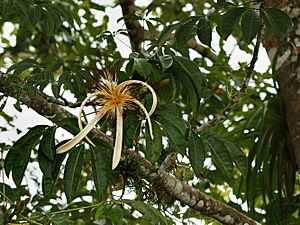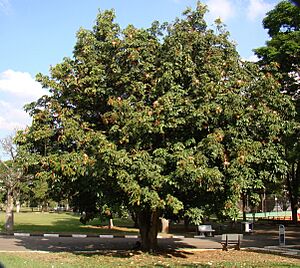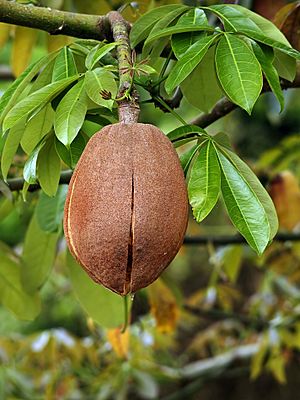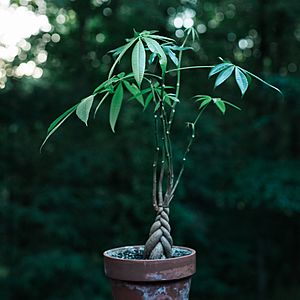Guyana chestnut facts for kids
Quick facts for kids Guyana chestnut |
|
|---|---|
 |
|
| Scientific classification | |
| Genus: |
Pachira
|
| Species: |
aquatica
|
| Synonyms | |
|
Carolinea macrocarpa |
|
The Pachira aquatica is a tropical tree. It belongs to the mallow family, Malvaceae. This tree naturally grows in wet areas like swamps. You can find it in Central and South America.
People call it by many names. Some common names are Malabar chestnut, French peanut, and Guiana chestnut. It is also known as the Provision tree or Saba nut. In stores, it is often sold as a Money tree or Money plant. Sometimes, you might see these trees with their trunks braided. They are popular as houseplants. However, the houseplant sold as "Pachira aquatica" is often a similar species called P. glabra.
The name Pachira comes from a language spoken in Guyana. The word aquatica is Latin for "aquatic," meaning it likes water. This tree is part of the Bombacoideae group within the Malvaceae family. The name "money tree" comes from a story. A poor man prayed for money and found this unusual plant. He took it home, seeing it as a good sign. He then made money by selling plants grown from its seeds.
Contents
What Does It Look Like?
In the wild, Pachira aquatica can grow very tall. It can reach up to 18 meters (about 59 feet) high. Its leaves are shiny green and shaped like a hand with several "fingers." These leaves are called palmate. The tree has smooth, green bark that turns brown or gray as it gets older.
The tree forms a slightly thick root. This root helps it store water. Young branches are green. When grown outdoors, the P. aquatica develops a wide, spreading top. Its leaves are bright green and feel a bit leathery. Each leaf can have up to nine smaller leaflets.
The flowers of the money tree are very showy. They are among the largest tree flowers in the world. Their long, narrow petals open up like a banana peel. Inside, you can see many yellowish-orange stamens that look like a shaving brush. These flowers are greenish-yellow or cream-colored. They can be up to 30 cm (about 12 inches) long. Each flower has many stamens, usually between 180 and 250.
After the flowers, the tree produces large fruits. These fruits are woody capsules. They are brown, rough, and egg-shaped. They can be 20-30 cm (about 8-12 inches) long and weigh about 1 to 1.5 kg (2-3 pounds). Inside, each capsule holds 10 to 25 nuts.
Growing Your Own Tree
The Pachira aquatica grows well as a tropical ornamental plant. It needs moist areas that don't get frost. You can start a new tree from a seed or a cutting. It is a strong plant and can handle different growing conditions.
When you grow it indoors, the plant needs bright light. However, it should not be in direct sunlight. If you move it outdoors, do it slowly. This helps prevent its leaves from getting sunburned. This tree can grow well in regular potting soil. It also thrives in a hydroponic system, which means growing in water.
The plant likes room temperatures from 12°C to 25°C (54°F to 77°F). It can handle some shade. In autumn, when days are shorter, its leaves might turn yellow and fall off. This is normal and not a sign of sickness. The plant will grow new leaves in the spring. A tree is ready to produce fruit when it is 4-5 years old. It usually fruits in spring and fall.
The tree can survive temperatures as low as 5°C (41°F) without losing its leaves. However, it is best to keep it above 12°C (54°F). The perfect temperature is around 20°C (68°F) all year, with high humidity. A light frost might make it lose its leaves, but new ones will grow in spring.
For the best growth, keep the soil rather dry, especially in winter. Avoid dry air indoors. It's a good idea to spray or mist the plant daily. If the air is too dry, it might lose all its leaves. In its first year as a houseplant, you should not use fertilizer. After that, you can add some fertilizer when you water it in summer. This tree grows quite fast if it has good conditions. If it gets too big, you can trim it back to the size you want. New shoots will appear in about 1-2 weeks. Some varieties from Hawaii are grown as bonsai in lava stone. These grow very slowly.
The nuts from the tree are sometimes harvested. They grow inside a large, woody capsule. The nuts are light brown with white stripes. They are about 2-3 cm (1 inch) long. The capsule itself is not eaten. The nuts stay inside until the capsule bursts open and releases them. These nuts are considered edible. They taste similar to a European chestnut. Some people grind the nuts to make a hot drink. While people eat them raw or roasted, studies have shown that raw nuts can be harmful to rats. It's always best to roast them before eating.
Pachira aquatica in Culture
In East Asia, the Pachira aquatica is often called the "shake money tree" (搖錢樹). It has been a popular ornamental plant in Japan for a long time. In 1986, a truck driver in Taiwan started growing five small trees together in one flowerpot. He braided their trunks. This style became very popular in Japan and then across East Asia.
These trees are a symbol of good financial luck. You often see them in businesses. Sometimes, they have red ribbons or other decorations. The money tree is important to Taiwan's farming exports. In 2005, Taiwan exported NT$250 million (about US$7 million) worth of these trees. However, many plants sold as Pachira aquatica are actually P. glabra. This similar species develops a thick base sooner. It also has a smaller growth habit, less showy flowers, and smaller green seed capsules.
Images for kids
See also
 In Spanish: Castaño de Guayana para niños
In Spanish: Castaño de Guayana para niños








